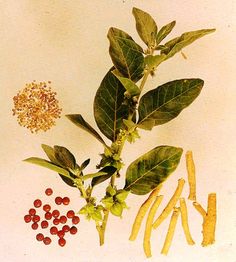|
The name Ashwaganda comes from the Sanskrit “ashva” meaning horse, and “gandha”, meaning smell, and refers to the odor of the root. It is an herb traditional to Ayurvedic medicine and has been used for over 4,000 years. It is specific for both men and women in regard to issues with fertility, stress, and general chronic disorders of the nervous system. It is classified in Ayurveda as a rasayana, one of a group of elite herbal medicines reputed to promote physical and mental health, to augment resistance of the body against disease and diverse adverse environmental factors, to revitalize and increase longevity. As with any form of herbal medicine, the below information is not meant to replace medical advice or prescriptions from your MD. All information below is based off of Materia Medica texts and comes from published and historical sources. Family: Solanaceae Parts Used: Dried Root and Leaves (for Withaferin A in cancer therapies) Other Common Names: Indian Ginseng, Winter Cherry, Avarada, Turangi-gandha Actions: General Tonic Rejuvenating Aphrodesiac Astringent Sedative Adaptogenic Anti-Inflammatory Immune Modulating Anti-Anemic Anti-Depressant Anxiolytic, possibly due to GABA-mimetic activity Antioxidant Nervous System Tonic Anti-Stress Anti-Tumor Oxytocic Hemopoietic Cardiopulmonary action Tonic to the Central Nervous System Cardiotropic Cardioprotective Anticoagulant Chemical Constituents: Steroidal lactones
What are its Uses?Head, Ears, Eyes, Nose, and Throat:
Integumentary System (Skin):
Mind/Mental Health:
Nervous System:
Respiratory System:
Digestive System:
Urinary/Renal System:
Endocrine System (Hormones):
Cardiovascular System:
Circulatory System:
Immune/Lymphatic System:
Reproductive System:
Musculoskeletal System:
Specific Diseases/States/Infections/Viruses/Bacteria:
Herbal Combinations
Clinical Studies
Safety Concerns/Contraindications
I hope you've enjoyed this article on the many uses of this incredibly ancient and reliable herbal ally. If you have any questions about this herb or its uses, or would like to contact me about other related herb/health concerns, please feel free to reach out to me directly via email by clicking here. In health and wellness, - Petra References
7 Comments
8/4/2020 07:33:48 am
I liked your educational contribution to spread the awareness. Thanks much
Reply
Thank you for sharing this information on news and articles understanding herbs ashwaganda withania somnifera. It was useful and interesting. You indeed have written it in a layman way so that anyone can understand and work accordingly. You have done a great job.
Reply
6/22/2021 11:19:24 pm
Hi. Thank you for sharing this very informative and useful article. Btw. I wanna share my experience about Genuine Haarlem Oil for Human since when I was started to using it for my health problems. Their products are very helpful both human and animals good for immune system booster.
Reply
I like to take care of my health, both physical and mental. To avoid deficiencies, I had to adopt a balanced diet and above all use a specific food supplement. It is on this article that I found the product that allowed me to relive and enjoy optimal well-being without health concerns.
Reply
This Blog Is Very Helpful And Informative For This Particular Topic. I Appreciate Your Effort That Has Been Taken To Write This Blog For Us. multiple sclerosis and physical therapy, ms rehabilitation center, physical therapy for ms near me, multiple sclerosis rehab centers, multiple sclerosis contraindications physical therapy, multiple sclerosis rehab, rehab for ms patients, physical therapy multiple sclerosis treatment, physical therapy for multiple sclerosis patients. <a href="https://curerehab.in/Multiple-Sclerosis-Rehabilitation"> physiotherapy in hyderabad </a>
Reply
Leave a Reply. |
Petra Sovcov is not a Medical Doctor (MD) nor a Naturopath (ND), she is a Clinical Herbal Therapist (CHT) and holds a Doctorate in Natural Medicine (DNM). The suggestions or recommendations made on this site are not meant to be a substitute for advice from your MD, or as a substitute for any prescriptions you may be taking. Suggestions followed will be the responsibility of the reader, and are stated with the intention of interest and education only. If you have a health issue, please see your primary care physician (MD) first and foremost. Categories
All
Archives
July 2024
|


 RSS Feed
RSS Feed